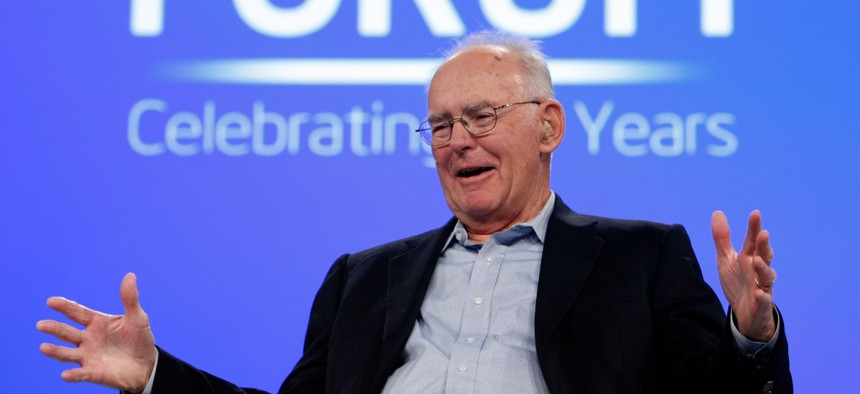The true lesson of Moore's Law is not about chips

Intel co-founder Gordon Moore speaking at the 2007 Intel Developer Forum in San Francisco. Gettyimages.com/JustinSullivan
Beware of thinking too narrowly about that certain rule coined by the late Gordon Moore. Whether he intended it or not, the idea of Moore's Law is more about what makes innovation and investment go than it is transistors on a chip.
Where does one even start to quantify the legacy of a pioneer and trailblazer like Gordon Moore, the co-founder of Intel Corp. who died on Friday at 94 years of age.
Moore's Law has been one of the technology industry's golden rules, and perhaps *the* golden rule, since the man himself predicted in 1965 that the number of transistors on a computer chip would double every two years for the foreseeable future.
This New York Times obituary on Moore's life highlights how he later came up with two additional follow-up points to the rule he proposed. Computers may get more expensive to build, but consumers would pay less for them because of how many would get sold.
Technology companies have since oriented their entire product development and business strategies around what Moore first predicted.
Some like Nvidia CEO Jensen Huang have called Moore's Law dead, but Intel's chief executive Pat Gelsinger believes the rule is very much alive. Gelsinger most likely had a direct line to the law's creator of course, and paid his own tribute to Moore in this LinkedIn post:
We leave to others the verdict on the remaining lifespan of Moore's Law from a pure chip production perspective, and wonder what he made of the ongoing semiconductor supply problems.
That transistor doubling rate Moore predicted is far from the most important point of that law he created anyway.
Whether he meant it or not, the idea and concept that Moore's Law should teach us is the most important point: investment and innovation spurs on more of it, with others following on from the work of those before them.
Many of the technologies and systems that dominate today's landscape only got that way because of Moore's Law economics. The public sector is no exception, particularly as its buyers want the kind of technology that the rest of the world has.
Consider the Defense Department's push to go all-in on commercial cloud computing, whether it be called JEDI or now the Joint Warfighting Cloud Capability.
DOD was going down that path no matter what and mainly because that desired technology is developed and cultivated in the private sector. Contrast that to the kind of government-driven investment in new technology development in Cold War times.
GPS traces its roots to how the U.S. military responded to the Soviet Union's Sputnik satellite that spooked an entire country. High-performance computing started out of a need for nuclear research.
Artificial intelligence only became a thing because of Defense Advanced Research Projects Agency money and evidently is on a path to being in everything. ChatGPT anyone?
Once private sector enterprises took over the economic driver role the government had, the pyramid of investment and innovation flipped. Even with today's banking sector difficulties, the worlds of private equity and venture capital are where much drive the technology investments happening these days.
Before the era of continuous virtual events: just about every event I attended on technologies and budgets would point out that U.S. government spending on research-and-development continues to trend down, while private sector R&D trended up.
Moore’s Law economics has also taken afoot in the space domain and in particular the world of commercial satellite imagery.
Whereas the government once largely took a single-sourced approach, now the imagery market is replete with several players that have made inroads with their own specialized offerings. A few companies may still sit at the top, but they do not have the playing field all to themselves.
The literal interpretation of Moore's law says it is losing relevance, and perhaps could soon no longer be relevant due to the physical limitations of computer chips and how many transistors can go on them.
But being too literal with respect to the rules of life, technology and business has its own limitations as well. Moore was right on the money with the business lesson that his golden rule teaches.
